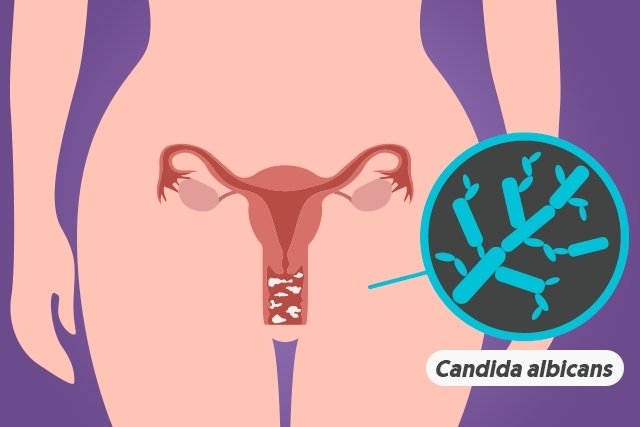Vaginal yeast infections are one of the most commonly occurring infections in women due to the short distance between the urethra and vagina. This small anatomical detail lends itself to a higher risk of imbalances in vaginal flora, which can promote favourable conditions for the development of Candida fungus (or most commonly seen, Candida albicans).
An imbalance of vaginal flora and an increase in Candida fungas can be related to stress, inadequate hygiene, excessive antibiotic or corticosteroid use, pregnancy and weakened immune system (e.g. from other ongoing illnesses).
The symptoms of a yeast infection are usually similar in all cases. Women often report itching, a burning sensation in the genital area and a white discharge. It is important to consult your doctor or gynecologist if you experience any of these symptoms. He or she will assess you and, if confirmed, will indicate recommended treatment (usually antifungal creams or pills).

Symptoms of vaginal yeast infections
Symptoms of vaginal yeast infections typically emerge when a woman's immune system has become weakened. The most common symptoms include:
- White discharge, with a cottage cheese appearance
- Intense itching or burning in the genital area
- Pain and burning with sex
- Swelling or redness in the genital area
Women with these symptoms should consult their doctor or gynecologist. He or she will likely perform a vaginal exam (like a pap test) to confirm diagnosis and recommend appropriate treatment as indicated.
Although the above symptoms are very typical for yeast infections, they can also be a sign of another gynecological issue. Report your symptoms below to gain an understanding of what you may have:
How vaginal yeast infections are treated
Treatment for vaginal yeast infections should be completed under the supervision of a gynecologist. Usually, antifungal creams are applied directly to affected area, but your doctor may also prescribe oral antifungals like nystatin, miconazole, itraconazole or cetaconazole.
Medication should be taken as prescribed and sex should be avoided during treatment (especially if you are using antifungal creams).
In some cases, oral antifungals like fluconazole can be prescribed as a single dose or as 3 doses, taken once every 72 hours (ie. one pill every 3 days). Vaginal yeast infections that keep reoccurring should be treated with an oral antifungal taken once per week for 6 months, or as prescribed by your doctor. Both oral and topical antifungals are effective, however symptoms can actually improve quicker when antifungals are applied directly on the affected area. This can be done with creams or vaginal suppositories.
Home remedies for vaginal yeast infections
A great home remedy for yeast infections involves washing the genital area with water and vinegar (with a ratio of 4 tablespoons of vinegar to 500ml or 2 cups of water). In addition, you can help to prevent a yeast infection from recurring by:
- Washing and drying your genital area before going to bed
- Using loose clothing with cotton-based fabrics
- Ensuring a healthy intake of foods with probiotics and lactobacillus (like yogurt)
- Sleeping without underwear
- Douching with products that have a pH between 3.8 and 4.5, and avoiding chemical products and soaps.
It is also important to avoid foods that are high in carbohydrates, fat and sugar, as these will promote the growth of the fungus that causes yeast infections.
Foods that help with treatment
A great way to cure a yeast infection is to drink lemon water throughout the day (with no added sugar). Natural yogurt is another excellent option and can be applied directly to the vagina.
